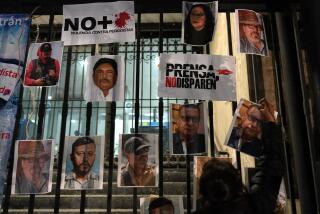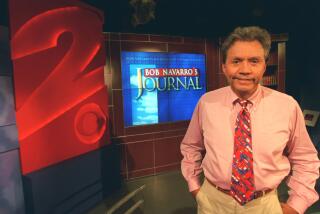COLUMN ONE : A Deadly Beat for Journalists : The Philippines leads the world in murders of members of the press. Gangsters, gamblers, loggers, Communists and anti-Communists have all picked off some.
- Share via
OZAMIS CITY, Philippines — A great many people had reason to silence Nesino P. Toling, chief reporter, editor and publisher of the Panguil Bay Monitor.
There is the governor who Toling accused of taking kickbacks. The general he said was protecting illegal loggers. The various mayors and local officials he exposed for bribery, stealing public works equipment and using police cars to go to cockfights.
Then there’s the wealthy businessman Toling helped jail as a “drug lord.” The religious cult leader he denounced as a “great imposter-swindler.” The high school principal he alleged pocketed student yearbook funds. The police lieutenant he exposed for extorting money from 52 security guards.
They were only a few of Toling’s targets. For three years, the 46-year-old editor used his scrappy six-page weekly in western Mindanao to crusade against graft, corruption and human rights abuses by local military, government and business leaders. Few escaped his ire.
But Toling couldn’t escape his foes. He was shot in the head three months ago as he scribbled another drug-trafficking expose in his tiny newspaper office. So far, police have 21 possible murder suspects.
“He created many enemies,” explained Lt. Col. Credo Rubio, provincial head of the Philippine National Police. “So we have many motives to consider.”
If Toling’s murder was no surprise, neither was it unusual. Since democracy was restored in 1986, 32 journalists have been reported killed in the Philippines. Scores more were beaten or threatened. Indeed, the New York-based Committee to Protect Journalists says more journalists were killed here in three of the last four years than in any other country.
“Journalists are becoming an endangered species,” Romeo del Castillo, former president of the National Press Club in Manila, complained recently. “They’re being picked off like chickens.”
The picking comes from all sides. Ten were killed by Communist rebels. Five were shot by anti-Communist vigilantes, or in right-wing coup attempts. Ten were victims of gangsters, gamblers and illegal loggers. Beyond that, like much in the Philippine press, exaggeration clouds the truth. At least three died in disputes unrelated to their work. And several were not so much journalists as paid propagandists or corrupt radio commentators.
“They’re what we call AC-DC journalists,” said Manuel S. Satorre Jr., editor of Newstime, a daily in Cebu province. “They attack and collect, then defend and collect.”
But the danger is real enough, especially for provincial journalists. In recent months, an angry soldier forced a reporter in Masbate to eat his morning paper. A Pampanga mayor’s bodyguard badly beat a radio reporter who broadcast stories about local water pollution. And a south Cotabato police officer held a pistol to a DXKR radio announcer’s head and forced him to pray for his life on the air.
“Here in the provincial press, it’s normal to get death threats,” Satorre said. “We are closer to the sources. If you hit someone here, they can hit you back.”
In a society torn by political violence, reporters aren’t the only victims. But the perils of Philippine journalism reflect the unruly growing pains of democracy since President Corazon Aquino restored full press freedom after 14 years of heavy censorship and brutal repression under strongman Ferdinand E. Marcos.
Today, the freewheeling Philippine media--28 Manila-based and 298 local newspapers, 232 radio stations and 61 TV stations, at last count--is probably the least restricted and least inhibited in Asia. Critics, including Aquino, say it is also often the least responsible.
“Sometimes . . . the country we read about is not this Philippines, but a terrible cursed land in an outlandish world created by the imagination of reporters and columnists,” she told foreign correspondents last October.
Aquino went further in February, when she became the first president to take the witness stand in a libel suit. In two hours of bizarre televised testimony, she angrily denied newspaper columnist Luis Beltran’s stunning claim that she “hid under the bed while firing was going on” during a failed August, 1987, coup attempt.
No one disputes the denial. After reading Beltran’s column, the furious president called reporters into her bedroom to show that her platform bed hugs the floor. Aquino testified that the column made the commander in chief look like “a coward” and insisted her goal was “to seek the truth.” Her suit, which seeks $144,300 in damages, is unresolved.
Beltran, a popular radio and TV talk show host, has apologized and says he used a “figure of speech” and didn’t intend to be taken literally. But his account helps explain how the media often operate here.
Although standards are improving, Manila’s so-called national papers still print rumors as fact and speculation as truth. There is little digging, or follow-up. Press releases routinely appear as news stories. Many of the estimated 150 columnists in Manila seem to specialize in name-calling and coffee shop gossip. Few appear to check for accuracy.
“There’s no professional discipline,” said Melinda Quintos de Jesus, director of the privately funded Center for Media Freedom and Responsibility in Manila. “That’s obvious when you look how common it is for someone to get fired from one paper and get hired the next day by another.”
Take Larry Henares. Last Sept. 9, his popular “Make My Day!” column for the Philippine Daily Inquirer was copied almost line for line from a Los Angeles Times-Washington Post News Service feature published the week before in the International Herald Tribune, which circulates here.
After another Manila paper noted the plagiarism, the Inquirer apologized and suspended the column. Henares was quickly rehired by the Manila Standard but not before defiantly responding that Washington Post writer Glenn Frankel’s story was not “of literary value” and that he “had to rearrange and improve his convoluted prose.” Henares rejoined the Inquirer last month.
More importantly, credibility is undercut by “envelopmental journalism”--named for the envelopes of cash passed to reporters and editors. The practice peaked under Marcos, who paid tens of thousands of dollars to friendly journalists, according to documents released in last year’s federal trial of Imelda Marcos in New York. The practice is still common.
“We don’t do it, but almost every other beat has money going around,” said Horacio Paredes, an Aquino spokesman. “The business beat is pretty lucrative.”
After officials unsuccessfully tried to deport millionaire businessman William Tiu Gatchalian last August, for example, rumors flourished that reporters and columnists soft-pedaled coverage for cash. Immigration chief Andrea Domingo said she “heard” that 28 reporters were “on his payroll” for 5,000 pesos ($182) a month, or considerably more than most reporters’ monthly salaries.
Domingo says now she can’t confirm the rumor. Nor is it easy to prove widely told tales of prominent columnists and editors being given condominiums, cars, computers, trips abroad and other expensive gifts. Those reporters who go public on payola are often ostracized by their peers.
Several papers and the National Press Club have promulgated ethics policies, but Teodoro Benigno, a respected columnist and former Agence France-Presse bureau chief, insists payola remains “widespread, very widespread.”
The problem, he said, is partly low salaries, partly cultural. “It’s very hard for journalists to be honest in a system where so many are dishonest,” he said. “Our politicians, our elite, are not exactly paragons of virtue.”
Virtue is relative in any case. While Americans debate whether the media should identify rape victims--as NBC News and the New York Times did recently in the William Kennedy Smith case in Florida--TV news broadcasts here regularly name and show pictures of rape victims. Gory close-ups of bloody bodies are a staple; one corpse shown recently had pencils sticking out of his many bullet holes, presumably to help viewers trace the trajectory.
Radio, the most important medium, is equally lively. During the December, 1989, coup attempt, stations filled the air waves with frenetic around-the-clock coverage. Some reports were dead wrong. Others were dangerously accurate.
One station, for example, announced government troop positions, as well the vehicles and weapons they used. The military complained that rebels adjusted their aim after hearing radio reports of where their artillery fire was landing. The government briefly closed two stations for sedition, including one that erroneously reported Aquino had fled the palace during the fighting.
Such errors are rarely retracted. One reason, analysts here say, is that most TV and newspapers are privately owned by powerful families or consortiums less interested in public service than in promoting their own business and political interests.
The cost is high since only one Manila broad sheet, the Manila Bulletin, is known to make a profit. Advertising and readership are just too small to support so many papers.
“It’s simple,” said Joel Palacios, a former Reuters reporter who has studied ownership of the Manila press for the U.S. Information Service. “The owners can afford to lose money. They’re tax havens.”
For all that, Philippine journalism is improving. One reason is time: Many of the young reporters who cover Aquino, Congress and other critical beats were hired directly from schools in the fierce competition to open papers after 1986. Five years’ on-the-job experience has helped.
Also, the press increasingly is a watchdog on government. Recent media criticism led to the cancellation of a controversial petrochemical complex, the firing of Cabinet secretaries and a rollback of gas price increases. And although Manila media rarely cover the provinces, they gave extensive on-the-scene coverage to last month’s eruption of Mt. Pinatubo and the resulting hardship.
Hardship was daily fare for Toling, the owner and editor of the Panguil Bay Monitor. He had no computer, car or phone. Instead, he pounded an aging typewriter in a tiny, two-desk office. Then his wife, Virgie, took a three-hour boat and bus trip to the nearest printer. Three days later, she bundled the 3,500 issues and carried them back home.
“Sometimes we broke even,” said his wife. “But a newspaper was his dream.”
Ignoring repeated death threats, Toling named “crocodile mayors,” scored “unscrupulous contractors,” and blasted corrupt customs and public works officials. His last editorial, titled “Graft and Corruption,” focused on “lawmen working hand-in-hand with vice lords and criminal syndicates.”
Unlike his Manila colleagues, Toling published denials, corrections and rebuttals. More importantly, according to police Lt. Col. Rubio, “all of his exposes are true.”
At sunset on April 14, someone walked into Toling’s office and fired five shots. Police have arrested a security guard but say he was a paid killer.
Until they can find the mastermind, they have advised other local journalists to carry guns.
For now, Toling’s widow keeps a .38-caliber pistol in her desk and has assumed her husband’s role as publisher.
So far, she has accused police of illegally selling ammunition, alleged bribery of prison officials and reported misuse of typhoon emergency funds and supplies.
“It is very difficult,” she said. “Sometimes I think I cannot go on. I am a medical technician, not a journalist. But whoever killed him thought he would be silenced. So I must continue his crusade. In fact, I’m looking for an editor even bolder than him.”
More to Read
Sign up for Essential California
The most important California stories and recommendations in your inbox every morning.
You may occasionally receive promotional content from the Los Angeles Times.











